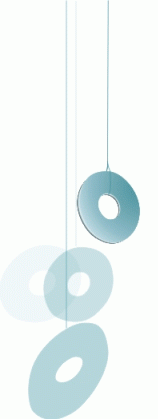

 |
 |
|||
|
Incredible Ladies
Articles Columns/Blogs
Word of Mouth |
Legs - Exercise Guide for a Sublime Appearance!
Why Legs?Have you ever seen 'Some Like it Hot'? Marylin Monroe 'high heeling' down the platform with this unforgettable swing of the hips and the little skip when the steam comes out of the engine? Who wouldn't want to look like that! Whenever a woman makes an 'Entry' her legs are shown. Even in a long gown you can see a silhouette, or she is coming down the stairs where the legs look even longer. Strong legs give you a strong posture. I count the bum into the leg bit as it is trained in one go with the upper leg. And a strong rear defines the hip area and helps to keep the back in an upright position. If you have short big legs like me, all one can do for starters is to distract from them. Actually, given the shape of my legs, I shouldn't be the one giving the advice here. But I know that the stuff I'm presenting here is working. I know it because most the women who have the legs I want, do the same - well a few have 'LEGS' naturally - and I'm turning all yellow of envy only thinking of it, but all the others have to work hard for these important assets. And I know that it is working because three years ago it wouldn't have been possible to shoot the picture above. At least I got into a state now where I am able to lengthen my legs by wearing tight flared trousers and high heels. So I'm determined to make it throught the rest of the way as well. In 'How to Handle Weights' I explained that the upper body is only holding the weight. The actual lifting is all done with the legs. This applies for sport as well as for daily life. That means that strong legs will help you to keep the rest of the body healthy.
Apples and Pears again! As a pear I always had huge column like legs, including the fat ankles. For me, beautiful legs are a lifelong dream. My only advantage are my small hip bones and the round bum. Although the rear got rather huge at times I never had a flat arse - only a bit when I lost weight and the whole thing started sagging, but even then I could camouflage it with good trousers or skirts (long ones, obviously).
The difference between the two pictures above doesn't actually come from four years of exercise. Stupid me - would I have started working out straight away... For more than a year almost nothing happened, until in fall 2004 I started my Project Rika. As a consequence I lost some weight because I wanted to be able to wear all these nice clothes which I'd seen in the shops but which just wouldn't fit. That's when the bum started sagging, and from spring 2005 I went back to the gym regularly. I've put in the same effort into the upper and the lower body parts, but the legs just need a lot more time. I did very heavy leg exercises, but only since about 3 month I decided to change my training regime a bit and to do squats. And eventually the buttocks is starting to raise like a Phoenix from the ashes. Although I never will have those long gazelle like dream legs, athletic legs will look even better on me. And actually, if legs are too thin they loose their appeal. Round is sexy - bony is hurtful! Apples on the other hand usually have great legs. Due to the fact that they carry their weight high up, they are training their legs all day long just by walking. Their drawback usually are somewhat wider hips. The wider the hips the more difficult it is to get shape into the rear - it's just more area to cover. A flat rear makes the top bit look even wider and easily gives a 'No-waist' impression. A lot of African and Latin women have nice round bums, and even if they should be a bit on the heavy side in the upstairs as well they usually look shapely and sexy. So whether your main worry area is - the legs or something else - you won't get around a good leg workout as it builds big muscles which burn up a lot of calories, which will give you a good posture, a great shape and which will help you to achieve daily tasks much easier.
Exercise Guide for a Sublime Appearance!I like to split leg exercises into five groups:
Buttocks (Glutes) & Front Thigh (Quadriceps) Bottomline is: Whether you are a pear or an apple - You need a round bum to look good. That means squats are for you! The front thight is important as well and by doing squats you are covering the quadriceps as well. As I mentioned above: I only changed to squats about 3 month ago. I used leg press machines before and was able to do the whole pile of weights. I could press more weight than the average guy can lift - and look at the legs! They are all right, but they don't look like 'great legs' and the bum didn't change a bit during that time. So squat it is! There are more theories about how to do squats right than people doing them. You might hear a lot of controversial comments about deep squats like I am doing them. I never saw them taught to women by any of the gym instructors I observed, and they don't usually don't do them themselves - probably don't even know how to do them. There is one really good reason why I'm recommending them: This movement represents all the lifting movements in daily life. Every single tissue you pick up from the floor should be picked up in a proper squat. And to reach the floor you have to be able to go deep down. Deep Squats are the best way to keep your spine healthy and your bum and legs strong. If you are learning the correct technique you will automatically incorporate this posture into your daily life. I don't understand why women are so scared of them. This may be a bit sexist, but it is usually us ladies doing housework and shopping, don't we? That means lifting stuff all the time. For the upper bit of the rear end and the lower back there is a very technical but effective exercise called deadlift. I only started doing them since I am training together with Claire. We both need that bum-lift and it just didn't fit into my schedule with Detlef. But now we both feel it kicking in and love it. Some people are scared of them as a muscle ache in that area feels like back pain. However, it actually is an exercise that - if executed correctly - can help to heal back pain by strengthening the muscles which support the lower spine. Exercising the hamstring is very important as well. It is called 'hamstring curl'. It helps to keep the floppieness at bay and gives depth to the back of the thigh. The cross section of the upper leg has to be oval rather than round. The biggest muscles are in the front to stretch the leg (Quadriceps), and in the back to bend the leg (Hamstring). Smaller muscles are sitting high up close to the hips to adduct and abduct the legs. That means that the upper leg is mainly shaped by the big muscles in the front and the back. Ah well, and then there are the calves. They are nasty buggers - very hard to train and reluctant to respond. Nevertheless, the bottom bit of the leg is the fist thing that gets visible under a skirt - so a woman got to do what a woman got to do: Calf exercises are a must for shapeless or fat lower legs. I recently started an experiment on training the calves and with it the ankles because I felt they might need a bit of special convincing. Bits and Pieces There are smaller muscles attached to the pelvis on the inside and the outside of the leg called leg adductor and abductor muscles. They are responsible for the side movement of the leg. Squats cover those as well so guys usually don't do them - too girlie. Well, they usually don't have problems with wobbly bits between the legs and saddlebags. I won't have an exercise guide for those as the machines for those exercises are differing from gym to gym. If you want to incorporate them into your training plan, get an instructor to explain them to you and stick with the Three/12 Rule. I will cover them in the 'No Gym' section, though. As you won't be able to do heavy squats at home they are good additions to the leg training. Another exercise is called deadlift which helps for the upper bum, lower back and covers those bits mentioned above as well. It is coming from the weightlifting corner and needs quite a bit of technique, about which there are a lot of different opinions around. It basically is like a squat only that the weight is not on your shoulders but in your hands and hence in front of you. What needs a bit more bum sticking out - see: Handling Weight - Lifting one big weight from the ground. Furthermore there are lunges of all sorts. I don't like them as they put a lot of strain on my knees - something that usually is blamed on the squats. Additionally they feel very wobbly. I'm talking about stable posture in the 'Handling Weight' section. And lunges are not as stable as the gorilla posture used in squats. Then there are a lot of different types of leg press machines in the gyms. They mainly target the front thigh (Quadriceps) and a bit the bum. They all have a chair and a plate to put the feet on. Sometimes it's the chair that is sliding back when you are pressing against the plate, sometimes the plate is moving away from you. I used those and they are all right. You will have to get an instructor to get them explained to you. I used them for a while but didn't find them effective enough, because I needed the bum more than the legs - so I decided for the squats. If you don't feel comfortable with squats at all, then do leg presses instead and stick with the Three/12 Rule.
Numbers, Numbers, and a few things more!It's time to get started now. So here is the number of sets and repetitions and whatever else you need to know.
The problem with this exercise is the feet. Only very few adults are able to keep their feet flat on the ground when squatting. So you will need something to put under the heels. For my taste it could even be a bit higher than the weight plates. In order to have the ankles as flexible as possible, do some calf stretches at the beginning. And always do some squats without weight to get used to the posture and to check that you have all the lines and angles right. I have my knees and toes pointing forward. Some people (like Detlef) have the knees and toes pointing outward. You will have to try this out. But most importatly: During the exercise the direction of the knees is NOT supposed to change. During the 'UP' phase it is too tempting to squeeze the knees together and to wiggle with the bum: DON'T! This is a killer for the knees. If you have to do that, then either your weight is too heavy, you did one repetition too many, or you are not clenching your buttocks enough. So here are the numbers:
|
|||||||||||||||||||||||||||||||||||||||||||||||||||||||||||||||||||||||||||||||||||||||||||||||||||||||||||||||||||||||||||||||||||||||||||||||||||||||||||||||||||||||||||||||||||||||||||||
|
Pictures by Babul
|
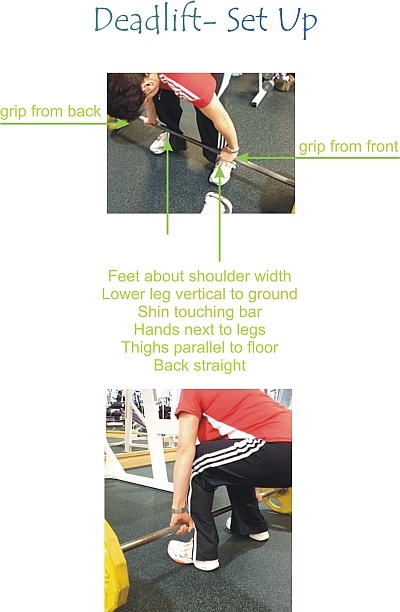
It is important to keep the weight as closely to the body as possible as the weight chosen should only allow 4-6 repetitions - meaning that this is really heavy, usually around your own body weight or more.
Best wear long trousers as the bar has to stay in touch with the leg at all times, thus sliding up and down. That just hurts without a layer of cloth in-between and better don't wear your favourites.
Set yourself up according to the images above. Consider wearing gloves to avoid sliding. When it is getting really heavy you can use straps around the wrist which gets wrapped around the bar and grabbed tight. This way the wrist and not the fingers are holding the weight.
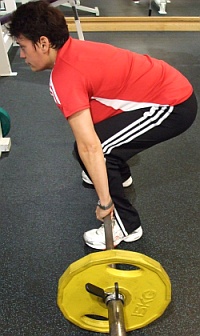 |
Build up the tension and lean back a bit to feel the weight, clench the buttocks and only lift when you are entirely comfortable. As usual: Always test the weight first before you actually lift.
From this side view you can see that you might have to adjust that set-up a bit according to the proportions of your body. Claire has incredibly long legs - don't we hate her for that... - compared to her upper body. So she will have to keep her lower legs a bit at an angle to be able to reach the bar. Additionally with higher weights the bar will come up a bit higher what will make it easier for her. Basically: short legs, longer upper have it a bit easier in the set-up. However, it is important that you can keep the weight close to your legs, that the back is straight and that you can feel the muscle work but there shouldn't be the slightest bit of pain. |
| Take a deep breath in, lift the chin up first, the upper body follows pulling the bar with it sliding up the shins.
On sliding over the knees push the hips to the front and entirely straighten the legs, while slowly breathing out all the way long. In the end position the shoulders are back and down, chest is pushed out towards the front.
|
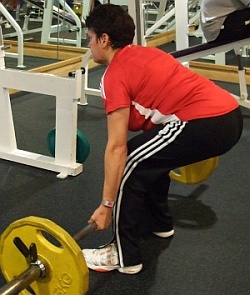
Here you can see that Claire is really hanging in the weight pulling it along the shin bones. Due to the length of the legs they get straight a bit earlier. For me with my short legs it is much easier to get the upper body almost straight until the legs straighten up. However, her back is nice and straight and the chin goes up and nicely leads the movement. Once the bar is above the knees the hips move to the front and the body straightens up. |
On breathing in, the body folds back as it came up.
The hips are moving back and the legs are starting to fold in first. The bar is sliding down the thighs and in reaching the knees the upper body is bending forward to let the bar slide down the shin bones.
Make sure that on the UP movement the upper body moves first and on the down the legs and rear bend first. It is a bit like a puppet. If you pull the strings the head comes up, then the thorax and then the legs. If you let it down again the legs fold back first, then the thorax and then the head.
At the beginning you may want to put the bar down, stay in set-up stance, have a breath in-between before you lift it up again.
The aim however is to just have the weight hover above ground before you lift it up. As the movement is slow and controlled and you have to adjust the breathing to this movement this will turn out to be a breathtaking exercise which has a rather high cardio effect as well.
| Deadlifts - For Buttocks and lower back | |
| Number of sets: | 3-4
|
| Number of repetitions: | Warm-up: 8 light weight (50%)
Those are huge muscles which need and can take a lot of weight. 4-6 repetitions where the last feels heavy but not exhausted are appropriate. Like in squats it's not possible to exhaust the muscle. To avoid injuries is paramount. |
| Duration: | 15-20 minutes you will need rather big breaks to get the heart rate down. Walk around a bit. Time depends if you are sharing a bar and having to change weights. |
| Progress: | 6 is absolute cut off. |
|
Pictures by Rika
|
![]()
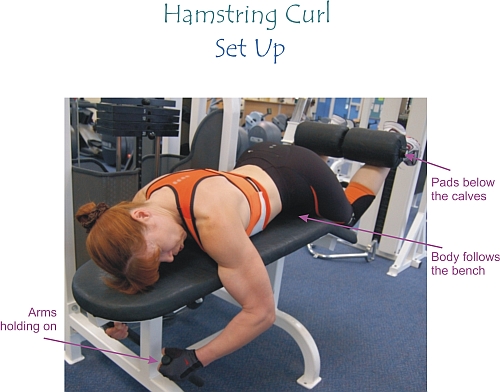
This exercise is very much straight forward. The bench usually can't be adjusted so you lie down following the shape of the bench with the upper body and the thighs. The knees move freely and are not lying on the bench.
![]()
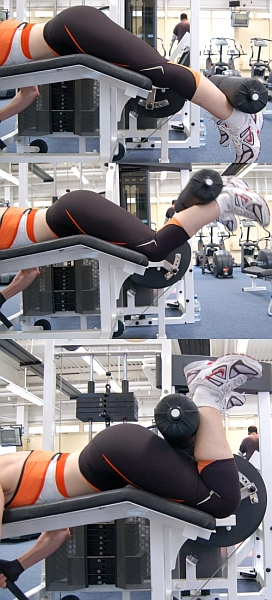 |
The leg attachment which is the bit that moves has at least a length adjustment and sometimes an angle adjustment as well.
Place it in a way that the pads end up below the calves and that you can feel a very slight pressure when your legs are still straight. Feel the pressure point. Take a deep breath in and lift the weight by only bending the knees until the pad touches the thighs while breathing out. Let the weight down in a very nice and slow movement while breathing in. Do not let the weight rest on the bottom pile. It is supposed to be 'in the air' during the whole exercise. The down movement is as important in this exercise as the actual lifting of the weight. |
| Hamstring Curl | |
| Number of sets: | 4 |
| Number of repetitions: | 8 - 12 |
| Duration: | 8 - 12 minutes
I find this exercise rather breath-taking, thus I allow a bit bigger breakes. If I'm a bit in a rush then I can speed it up by shortening the breaks, what usually cost me some repetitions in the third and fourth set. This is not a problem. I only take care that I don't do this every time. There have to be sessions in between where I enjoy the longer breaks and can do more reps or can increase the weight. Hamstrings are big muscles and they need the big weights which are not possible when rushing through it. Cutting a long story short: Variation is good between
However, the last repetition always has to be the last possible. Keep a training diary to find your best break/weight/rep proportions. |
| Progress: | 14 is absolute cut-off.
Usually the weight plates are rather heavy for women. That means that increasing the weight might make you drop to 6-8 repetitions. This is one reason why I don't like the machines a lot. The weight increase is measured for guys. So we have to train to higher numbers of repetitions. So if your machine has small plates then increase weight when you feel that 12 are too easy. If the plates are big then train up to 14 before you increase. |
|
Pictures by Babul
|
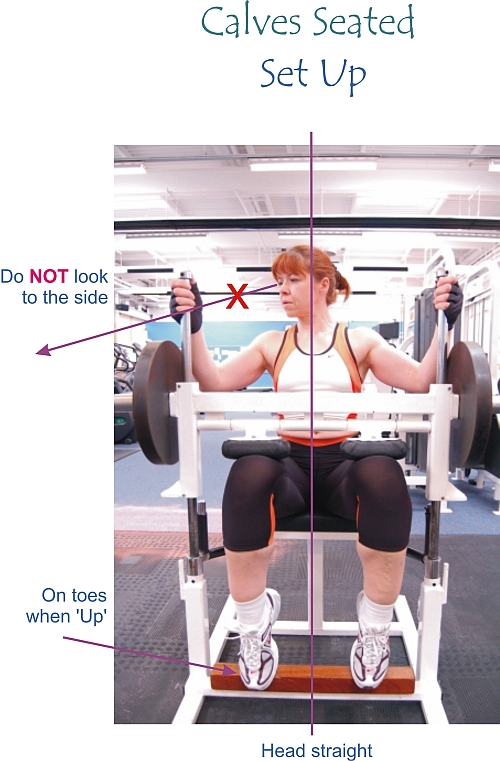
I'm not entirely happy with the photos of the seated calf exercise because I have the head turned. At first I thought Babul had taken the shot before I was ready, but then I realised that this is something that happens very easily and since then I saw that quite often in the gym.
When the weight is not positioned in the range of vision when the head is straight one tends to turn the head to see the weight moving. Wrong, wrong, wrong!
The head has to stay straight on the shoulders!
When it is getting heavy every muscle in the body is flexing in order to help the main muscle to get the job done. If the muscles which counter each other (here the two sided of the neck which hold the head in position) are not pulling equally you easily tear a muscle.
That's why I actually have a bit of an obsession with lines and angles. And again - even in the gym a bit of 'Photo Therapy' does good. That is one reason for working out with a partner. Sometimes there are mirrors but they are positioned at an angle to the equipment and one automatically starts looking into the mirror. Really, really try to avoid that! Set yourself up, check the posture in the mirror and then go blind. A lot of exercises I even do with eyes closed. It's like looking inside and visualising what the muscle is doing.
![]()
The movement is very simple. The toes are positioned on a raised board and the weight is attached to the pads which are positioned on the lower thighs. Be careful not to put pressure on the knees.
Take a deep breath in and lift the heels as high as possible while breathing out. The whole weight is resting on the toes.
While breathing in gently let the weight down and let the heels sink below the level of the toes.
That counts as one repetition.
The movement is rather slow and continuous. The 'down' movement is as important as the 'up' movement. Try to reach the highest and lowest possible point in every repetition.
Calves respond very reluctantly to training. They need rather high weights. You will be astonished how much weight you actually can carry with your calves - but imagine your own weight. That is about what they are carrying on a daily basis. So you have to top that. And they need a while until they are starting to burn - and they have to. Calves have a very specific feel, very different from any other muscle when they are trained hard.
After the set I have to move. I'm moving a lot anyway. When exercising to the very last repetition the heart rate goes up and I just have to walk a bit to find a bit of breath again. And calf just make me move - whether I want it or not.
| Calf raise - Seated | |
| Number of sets: | 3 |
| Number of repetitions: | 15-20 |
| Duration: | 5 - 8 minutes |
| Progress: | When using very heavy weights cut off is 20.
Sometimes I feel more like endurance training then I use lighter weight and go up to 30 repetitions. But that is the absolute limit. |
|
Pictures by Babul
|

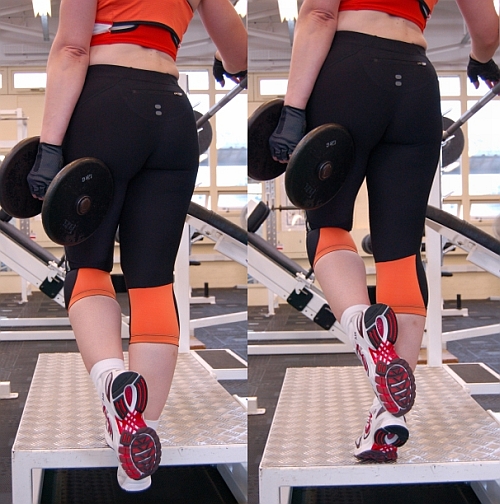
In order to get enough weight on the calves - substantially more than your body weight, as you are carrying that anyway all day - this exercise needs to be done on one leg.
You would start with no dumbbell and then gradually increase the weight. Make sure that the hand with which you are holding on to something for balance is not clenching. One tends to help the movement by pushing the body up using the arm.
At the lowest point the heel is below the level of the platform - make sure the whole front foot is on the platform so that you won't slip - and at the highest point the leg is as stretched as possible.
This exercise is a bit more time consuming as the legs are trained separately, although the breaks don't need to be as long as one leg is resting while the other one is trained. The free foot can be rested comfortably on the back of ankle of the other one.
The breathing is the same as usual. Weight up = breathe out, weight down = breathe in.
| Calf raise - Dumbbell | |
| Number of sets: | 3 (each leg), take a rest after both legs have done a set |
| Number of repetitions: | 20 - 30
The weight can't be as high as with a machine. So the number of repetition needs to be higher. |
| Duration: | 8 - 10 minutes |
| Progress: | Tricky
This is a good beginner exercise and 30 is a cut off, otherwise it gets too boring and time consuming. So as long as you can hold a certain weight for long enough increase whenever you can do 30. If the weight gets too heavy you will have to swap to a machine exercise, or just stay on that level for 'maintenance', although then there will not be a lot improvement in shape and mass. You will have to decide on the shape you have reached by then. If you are happy just stick with it. |
|
Pictures by Babul
|
These exercises are not as static as the gym exercises with just an up and a down position. So I hope you will enjoy the movie and the exercises in it.
The same guidelines as apply as usual in exercising: When it is getting heavy - breathe out, breathe evenly and in the rhythm of the movement.
Try to hold the balance and keep the shoulders as parallel to the floor as possible without clenching.
Don't swing the legs higher then parallel to the floor. Try to feel the muscles involved and use them deliberately.
So, enough of advice, here it is: Leg Exercises with Rika
By the way, the music is home made from my MySpace friend Woodnickel.
![]()
| No Gym - What to do? | |
| Number of sets: | 3 |
| Number of repetitions: | 15 for each leg and swing/squat |
| Duration: | 15 minutes |
| Progress: | 20 repetitions per leg and swing/squat
25 repetitions per leg and swing/squat 4 sets of 25 repetitions |
|
|
![]()
![]()
Events
Norwich Half Marathon 08
Race for Life 2008
Rowing League 07/08
Imola: MH 10K, 07
Rika: Race for Life 07
![]()
General
Ballet for Oldies
Training Plan 2008
Boxing vs. Kickboxing
What Sport to Choose?
Tummy
An Experiment
Good Use for Chocolate
![]()
Being Strong
Women and Strength?
Why Muscles?
Lucky Number 12
Shoulders
Legs
Chest
Ladies are Stronger!
![]()
| Feedback |
Copyright 2007 incredible-ladies.com
|
Author: Rika
|